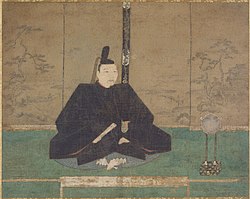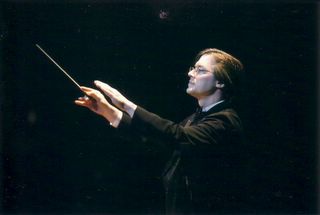The Leader Who Believed Ignorance Was Bliss
And now a bit of history...
When he was 8 years old, Ashikaga Yoshinari was given a shocking announcement. His older brother Yoshikatsu, the 10-year-old shogun (generalissimo) of Japan, had fallen off his horse and died. Now Yoshinari himself was to assume the mantle of military leadership, ruling the fractious nation of Japan in the Emperor's name (at least in theory). At first he just trained for the role while underlings ran things, but in 1449, at the age of 14, he assumed the title of shogun in fact, changing his name to Ashikaga Yoshimasa.
Ashikaga Yoshimasa
Things were already a mess when Yoshimasa came to power. The Imperial Court had divided into two bitter rival factions, the "legitimate" Northern Court and the rebel Southern Court, and their violent struggle for the throne had only just ended with the crushing of the Southern army. Shock waves from that conflict were still spreading. There was increasing tension between the samurai clans as well as within them as various issues of succession broke out. There were also spats between local daimyo (feudal lords) and the lieutenant governors of the shogunate overseeing them. Eventually, daimyo began openly defying Yoshimasa's rule.
So what did the reluctant, young shogun do to keep order in Japan in the name of the (Northern) Emperor?
Art & poetry. Yes, that's right. A whole era and genre of culture, the Higashiyama Culture, came about and flourished under his patronage. Drawing heavily from the teachings of Zen Buddhism, Higashiyama Culture included such things as sado (the Tea Ceremony), ikebana (flower arrangement), Noh drama, and ink painting. Basically, Yoshimasa did his best to ignore the growing troubles around him and instead held poetry recitations, tea ceremonies, and art exhibits in his garden while quaffing large amounts of sake.
Sado (Japanese Tea Ceremony)
Finally, at age 21, the tense reality of his position caught up with him, and Yoshimasa decided to step down. Having no heir, he adopted his younger brother Ashikaga Yoshimi and started grooming him as his successor. But then his wife went and bore him a son (Ashikaga Yoshihisa), and everything got really complicated. Yoshimasa changed his mind and decided to appoint his own child as his successor instead of Yoshimi. Yoshimi, however, had already gathered his own support base, so he began to press his own case...rather violently. Soon Yoshimasa's loyal supporters and Yoshimi's faction were busily killing each other and destroying the architectural heritage of Kyoto in a conflict known as the Onin War.
And what did the erstwhile shogun do while all this was going on? That's right! He had big parties in his various gardens and his newly constructed Silver Pavilion with lots of flower arrangement, poetry readings, art displays, and much quaffing of tea and sake. He enjoyed the finer pleasures of life while Kyoto burned around him. Finally, with the war still raging on, Yoshimasa handed the mantle of the shogunate over to his son, Yoshihisa, and stepped down.
The "Silver Pavilion" in Kyoto,
where Yoshimasa happily ignored everything.
Unfortunately, Yoshihisa died in battle after sixteen years as shogun, so Yoshimasa reassumed the office himself, adopted Yoshimi's son Yoshitane to groom as his successor, installed him as shogun a year later, and promptly died. By then, however, the period of civil war known as the Sengoku (Warring States) Era of Japanese history had already begun, and the Ashikaga shogunate was on its painful decline.
The leader who partied while his people became divided and his country fell apart around him...hmm....does that remind you of anybody?
When he was 8 years old, Ashikaga Yoshinari was given a shocking announcement. His older brother Yoshikatsu, the 10-year-old shogun (generalissimo) of Japan, had fallen off his horse and died. Now Yoshinari himself was to assume the mantle of military leadership, ruling the fractious nation of Japan in the Emperor's name (at least in theory). At first he just trained for the role while underlings ran things, but in 1449, at the age of 14, he assumed the title of shogun in fact, changing his name to Ashikaga Yoshimasa.
Ashikaga Yoshimasa
Things were already a mess when Yoshimasa came to power. The Imperial Court had divided into two bitter rival factions, the "legitimate" Northern Court and the rebel Southern Court, and their violent struggle for the throne had only just ended with the crushing of the Southern army. Shock waves from that conflict were still spreading. There was increasing tension between the samurai clans as well as within them as various issues of succession broke out. There were also spats between local daimyo (feudal lords) and the lieutenant governors of the shogunate overseeing them. Eventually, daimyo began openly defying Yoshimasa's rule.
So what did the reluctant, young shogun do to keep order in Japan in the name of the (Northern) Emperor?
Art & poetry. Yes, that's right. A whole era and genre of culture, the Higashiyama Culture, came about and flourished under his patronage. Drawing heavily from the teachings of Zen Buddhism, Higashiyama Culture included such things as sado (the Tea Ceremony), ikebana (flower arrangement), Noh drama, and ink painting. Basically, Yoshimasa did his best to ignore the growing troubles around him and instead held poetry recitations, tea ceremonies, and art exhibits in his garden while quaffing large amounts of sake.
Sado (Japanese Tea Ceremony)
Finally, at age 21, the tense reality of his position caught up with him, and Yoshimasa decided to step down. Having no heir, he adopted his younger brother Ashikaga Yoshimi and started grooming him as his successor. But then his wife went and bore him a son (Ashikaga Yoshihisa), and everything got really complicated. Yoshimasa changed his mind and decided to appoint his own child as his successor instead of Yoshimi. Yoshimi, however, had already gathered his own support base, so he began to press his own case...rather violently. Soon Yoshimasa's loyal supporters and Yoshimi's faction were busily killing each other and destroying the architectural heritage of Kyoto in a conflict known as the Onin War.
And what did the erstwhile shogun do while all this was going on? That's right! He had big parties in his various gardens and his newly constructed Silver Pavilion with lots of flower arrangement, poetry readings, art displays, and much quaffing of tea and sake. He enjoyed the finer pleasures of life while Kyoto burned around him. Finally, with the war still raging on, Yoshimasa handed the mantle of the shogunate over to his son, Yoshihisa, and stepped down.
The "Silver Pavilion" in Kyoto,
where Yoshimasa happily ignored everything.
Unfortunately, Yoshihisa died in battle after sixteen years as shogun, so Yoshimasa reassumed the office himself, adopted Yoshimi's son Yoshitane to groom as his successor, installed him as shogun a year later, and promptly died. By then, however, the period of civil war known as the Sengoku (Warring States) Era of Japanese history had already begun, and the Ashikaga shogunate was on its painful decline.
The leader who partied while his people became divided and his country fell apart around him...hmm....does that remind you of anybody?






1 Comments:
Thanks for this short insight.
Am I correct if I jump to the conclusion Yoshimi was not such a bad guy. As Yoshimasa did not really cared for the people.
Once Yoshimi also was used as a toy. Lost his religious titles for Yoshimasa he stood up. Not just himself but also for the people. As there is more than just party and art in life.
By Anonymous, at 2:37 AM
Anonymous, at 2:37 AM
Post a Comment
<< Home